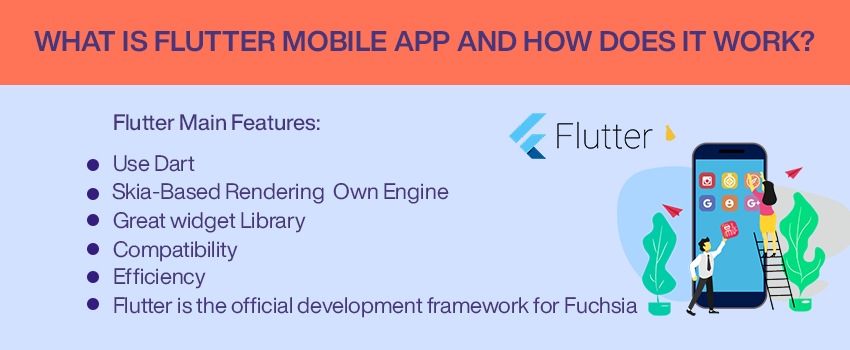What is Flutter Mobile App And How Does It Work?
Flutter is an SDK developed by Google to create mobile applications for both Android and iOS (Apple). It was developed as software for internal use within the company but they saw the potential it had and decided to launch it as an open-source project. It is currently one of the fastest-growing mobile application development projects. Also, since the last stable version, it is possible to make Web and desktop applications for Windows and Mac. Although on these two platforms it is still in an experimental phase (beta).

How Does Flutter Mobile App Work?
Explained very simply, Flutter uses a graphics engine, called Skia, that renders 2D graphic elements. Flutter is written in C, C ++, and mostly Dart. In summary, the engine layer is written in C ++ and that of the Widgets in Dart.
Widget is the most repeated word when referring to Flutter, it refers to the graphic elements that make up a view. For example, a button, text, or image. Although there are also more complex Widgets that are made up of other Widgets.
Flutter uses Dart as a programming language, also developed by Google. Possibly, this is a disadvantage, since Dart is not a well-known or used language by the mobile (Swift, Objective-C, Kotlin, Java) and web (JavaScript, PHP, Java, Ruby) community. Although it is very similar to Java and C # (Microsoft), if you have experience with any of these languages it is very intuitive to start with Dart. Although indeed, Dart does not yet include very useful features of new programming languages such as Swift and Kotlin, Google is evolving it to facilitate development with Flutter.
Flutter Main Features:
Use Dart
- It is a programming language for writing applications that were initially created to replace Javascript, in Flutter although it is written in Dart, that Dart language is compiled into the native ARM language.
- Something I would like to point out is that because Flutter refreshes the view tree for each new frame, it creates many objects that can only live for one frame.
- Fortunately, Dart uses generational garbage collection that is very efficient for these types of systems, because objects are relatively cheap.
- Another important point is that Dart also has a tree shaking compiler, which only includes the code you need in your app.
Skia-Based Rendering Own Engine
- One of the main features of Flutter is that it does not use the widgets that already come on mobiles as React Native or NativeScript do.
- Flutter has gone further and created its Skia-based rendering engine, so it does not use Web View or the OEM Widgets of the devices.
Great widget Library
- This is a section in which Flutter has worked quite well, the first thing that is observed when starting to work with this tool is that you have all the controls you need at your fingertips.
- Due to the way Flutter is distributed, everything is a Widget, working is very easy for the user.
Compatibility
- One aspect to value in Flutter is compatibility, in this sense a point that must be highlighted is that thanks to the fact that the widgets and the renderer for those widgets are part of your application and not of the platform, you will not need compact libraries.
- Apps will work the same way in recent versions of the operating system (iOS 8.0 and later and Android Jelly Bean and later).
- This reduces the need to test apps in previous versions of the operating system, it is also possible that your apps will work in future versions of the operating system.
- It must be said that there is some controversy regarding Flutter not using the native widgets of the platform.
Efficiency
- It is true that Flutter does not have communities as wide as NativeScript, Ionic, or React Native, however, this SDK is undoubtedly faster and more efficient than its competitors.
- It must be said that even though its competitors have more resources such as tutorials, courses, etc., however, the resources available in Flutter are growing by leaps and bounds as the platform becomes more popular.
Flutter is the official development framework for Fuchsia
- This feature is what will make Flutter and Dart, the language used to program in Flutter, a sensation in everything related to mobile development.
- What makes Flutter a tool with which to move to the next level in mobile development is the fact that it is the official development framework for Fuchsia.
- The interesting thing about all this for users who are dedicated to creating applications in Flutter, is that they are native applications for Fuchsia, so developers and programmers who start working with this tool are betting on the future.
Conclusion
Regardless of what resource you use, it seems that there has been no better time to learn Flutter than today, especially after it stopped being a mobile framework, to become a cross-platform one that will work on mobile, the web, desktop, chrome OS and embedded. AppTree develops high-quality Flutter Mobile App according to the latest technology.


